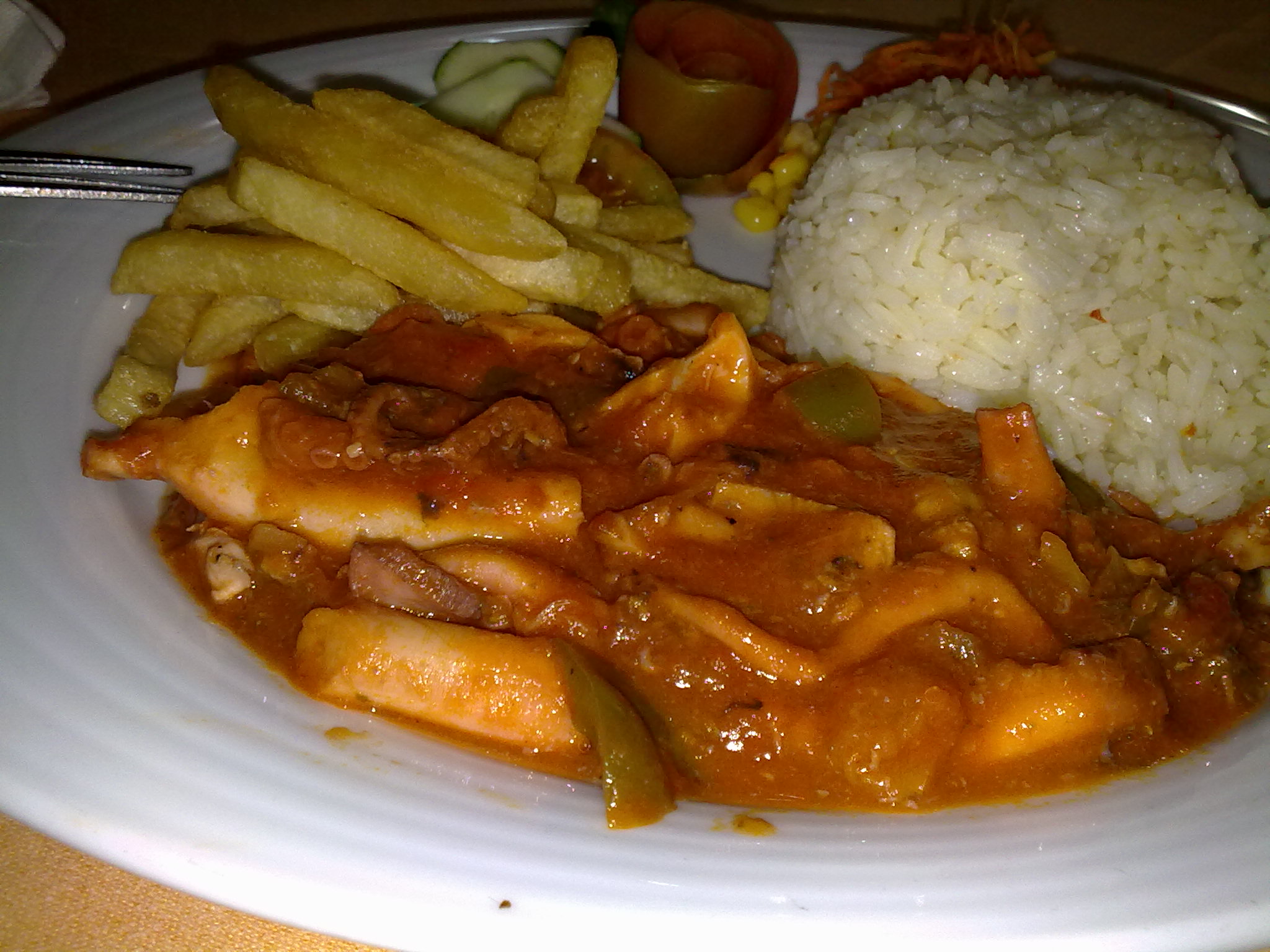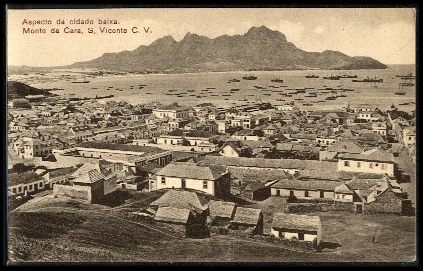|
Cape Verdean Cuisine
The cuisine of Cape Verde is a West African cuisine largely influenced by Portuguese, Southern and Western European and West African cuisine. Cape Verde was a colony of Portugal from its colonization until 1975. Because the archipelago is inside the Atlantic Ocean, fish is very important in Cape Verdean cooking. Overview One of the most important aspects of Cape Verdean culture is the beverage ''grogue'', a strong rum made from distilled sugar cane on the islands of Santo Antao and Santiago. The beverage is made in towns such as Paul on Santo Antao and Cidade Velha on Santiago using a ''trapiche''. A variation of the drink is ''ponche'' (punch) which is sweetened with condensed milk or sugarcane molasses. Due to the intoxication on consuming ''grogue'', it is consumed by many Cape Verdean musicians seeking inspiration. Corn and beans are staples of Cape Verdean cuisine. Also popular are rice, fried potatoes, cassava and vegetables such as carrots, kale, squash, fish and meat ... [...More Info...] [...Related Items...] OR: [Wikipedia] [Google] [Baidu] |
Cachupa 2
Cachupa (, Cape Verdean Creole ''Katxupa'' ) is a famous dish from the Cape Verde islands, West Africa. It is a slow-cooked stew of corn (hominy), beans, cassava, sweet potato, fish or meat (sausage, pork, beef, Goat meat, goat or Chicken (food), chicken), and often morcela (blood sausage). Referred to as the country's national dish, each island has its own regional variation. The version of the recipe called ''cachupa rica'' tends to have more ingredients than the simpler ''cachupa pobre''. Cachupa guisada ''Katchupa'' leftovers are often re-fried, the resulting dish being called Katchupa frita, cachupa guisada or cachupa refogada, meaning "fried ''Katchupa''". This dish may be served for breakfast with a fried egg and a fried local sausage (''linguiça'') or fried mackerel. Other There is also a Cachupa Rica style that is served at Quintal da Música, music restaurant and club in the Platô, Plateau and the Center of Praia. In São Tomé and Príncipe It is also one of the ... [...More Info...] [...Related Items...] OR: [Wikipedia] [Google] [Baidu] |
University Of Massachusetts Dartmouth
The University of Massachusetts Dartmouth (UMass Dartmouth or UMassD) is a public research university in Dartmouth, Massachusetts. It is the southernmost campus of the University of Massachusetts system. Formerly Southeastern Massachusetts University (known locally as SMU), it was merged into the University of Massachusetts system in 1991.UMassD website history. The campus has an overall student body of 8,513 students (school year 2019–2020), including 6,841 undergraduates and 1,672 graduate/law students. As of the 2019–2020 academic year, UMass Dartmouth had 402 full-time faculty on staff. The Dartmouth campus also includes the |
Ribeira Grande, Cape Verde
Ribeira Grande (also: ''Povoação'') is the largest town of the Ribeira Grande Municipality on the island of Santo Antão, Cape Verde. It has become a city in 2010.Cabo Verde, Statistical Yearbook 2015 Instituto Nacional de Estatística, p. 32-33 In 2010 its population was 2,564. It is situated in the northeastern part of the island, near the outflow of the river Ribeira Grande and its tributary |
Bafa (cuisine)
Bafa it a traditional dish of the Capeverdean cuisine.General menu including bafa at Hotel Dunas in Sal at Viajar Cabo Verde, by SAPO CV] , accessed 31 January 2017Gastromony at the municipality of Ribeira Brava's website , accessed 31 January 2017 It consists of a stew that can be prepared with s, |
São Vicente, Cape Verde
São Vicente (Portuguese for " Saint Vincent") is one of the Barlavento Islands, the northern group within the Cape Verde archipelago in the Atlantic Ocean, off the West African coast. It is located between the islands of Santo Antão and Santa Luzia, with the Canal de São Vicente separating it from Santo Antão. Geography The island is roughly rectangular in shape with an area of . From east to west it measures and from north to south .Cabo Verde, Statistical Yearbook 2015 Instituto Nacional de Estatística The island, of |
Sagres (beer)
Sociedade Central de Cervejas (SCC; full name: SCC – Sociedade Central de Cervejas e Bebidas, S.A.) is a Portuguese brewery, founded in 1934. Its main output is the Sagres brand of beers. The company has been controlled by Heineken since April 2008. History Sociedade Central de Cervejas was established in 1934, with the aim of selling the beers produced by the former breweriesCompanhia Produtora de Malte e Cerveja Portugália Companhia de Cervejas Estrela, Companhia de Cervejas Coimbra and Companhia da Fábrica de Cerveja Jansen. In 1935, and after 99 years of activityFábrica de Cervejas Trindadewas integrated by Sociedade Central de Cervejas (SCC). Centralcer – Central de Cervejas, E.P. is incorporated in 1977 as a result of the merger of Sociedade Central de Cervejas, S.A.R.L. (incorporated in 1934) with Cergal – Cervejas de Portugal, S.A.R.L. (incorporated in 1972). Centralcer – Central de Cervejas, S.A. was therefore created as a result of the above-mentioned ... [...More Info...] [...Related Items...] OR: [Wikipedia] [Google] [Baidu] |
Super Bock
Super Bock is a Portuguese beer brand from the Super Bock Group brewery which produces a range of beers under the same name. Established in 1927, Super Bock maintains a leading position in the market and it is among the favourite beer brands of the Portuguese. It is also the best-selling Portuguese beer in the world. History The Super Bock brand was born in 1927, launched as a "winter beer", directly entering the list of prestigious beers. Interestingly, Super Bock, even before being registered, won its first prize in 1926, in its presentation at the Industrial Exhibition at Palácio de Cristal, winning the gold medal. * 1942 - in the midst of World War II, Super Bock is produced entirely with national malt, due to navigation difficulties that lead to the use of 100% national malts for beer production, for the first time *1964 - Inauguration of the new production center in Leça do Balio with a capacity of 25 million liters per year, where the Super Bock and the other brands ... [...More Info...] [...Related Items...] OR: [Wikipedia] [Google] [Baidu] |
Strela (beer)
Strela is a beer that is produced by the company CERIS, based in the eastern part of Praia, Cape Verde. The name ''Strela'' is Cape Verdean Creole for "star". Production of the beer was started in November 2006, replacing the production of ''Coral'', a brand of CERIS's former owner Madeira Brewery. The beer is distributed by Cavibel. Both CERIS and Cavibel are owned by Equatorial Coca-Cola Bottling Company. Strela beer is exported to Gambia, Guinea and Portugal. In 2016, Strela beer received a Superior Taste Award The Superior Taste Award is an annual non-competitive prize open to any consumer food or drink product, subject to payment of an entry fee of Euro 750-1650. It is organised since 2005 by the International Taste Institute, who specialised in the s ... from the International Taste & Quality Institute (iTQi) in Brussels. In 2009, Strela was the second most consumed beer in Cape Verde, covering 35% of the market. References External linksOfficial website{{Alcoholic dri ... [...More Info...] [...Related Items...] OR: [Wikipedia] [Google] [Baidu] |
Bife De Tartaruga
Bife de tartaruga ("turtle steak") is a traditional Cape Verdean dish, particularly on the Ilha de Santiago. In December 2002, the Cape Verdean government prohibited the killing of turtles by law, in accordance with the country's obligations under the 1995 Convention on Biological Diversity and the Convention on International Trade in Endangered Species CITES (shorter name for the Convention on International Trade in Endangered Species of Wild Fauna and Flora, also known as the Washington Convention) is a multilateral treaty to protect endangered plants and animals from the threats of interna ... (CITES). Preparation To prepare the dish, turtle meat is cut into steaks and seasoned with salt, malagueta, garlic, and white wine. It is then left to marinate for an hour. It is then cooked with onion and butter over a high flame. The steaks are usually served with white rice and cooked mandioca. References {{DEFAULTSORT:Bife De Tartaruga Cape Verdean cuisine Turtl ... [...More Info...] [...Related Items...] OR: [Wikipedia] [Google] [Baidu] |
CITES
CITES (shorter name for the Convention on International Trade in Endangered Species of Wild Fauna and Flora, also known as the Washington Convention) is a multilateral treaty to protect endangered plants and animals from the threats of international trade. It was drafted as a result of a resolution adopted in 1963 at a meeting of members of the International Union for Conservation of Nature (IUCN). The convention was opened for signature in 1973 and CITES entered into force on 1 July 1975. Its aim is to ensure that international trade (import/export) in specimens of animals and plants included under CITES, does not threaten the survival of the species in the wild. This is achieved via a system of permits and certificates. CITES affords varying degrees of protection to more than 38,000 species. , Secretary-General of CITES is Ivonne Higuero. Background CITES is one of the largest and oldest conservation and sustainable use agreements in existence. There are three working langu ... [...More Info...] [...Related Items...] OR: [Wikipedia] [Google] [Baidu] |
Persististrombus Latus
''Thetystrombus latus'', commonly known as the Bubonian conch, is a species of sea snail, a marine (ocean), marine gastropod mollusk in the family (biology), family Strombidae, the true conchs.MolluscaBase eds. (2021). MolluscaBase. Thetystrombus latus (Gmelin, 1791). Accessed through: World Register of Marine Species at: http://marinespecies.org/aphia.php?p=taxdetails&id=1428085 on 2021-04-22 Description The shell size varies between 70 mm and 165 mm. Distribution The Bubonian conch occurs in the Atlantic Ocean off West Africa, Senegal, Gabon, Cape Verde, Ascension Island and Angola. References * Bernard, P.A. (Ed.) (1984). ''Coquillages du Gabon [Shells of Gabon]''. Pierre A. Bernard: Libreville, Gabon. 140, 75 plates pp * Gofas, S.; Afonso, J.P.; Brandào, M. (Ed.). (S.a.). Conchas e Moluscos de Angola = Coquillages et Mollusques d'Angola. [Shells and molluscs of Angola].'' Universidade Agostinho / Elf Aquitaine Angola: Angola. 140 pp. * Rolán E., 2005. ''Malaco ... [...More Info...] [...Related Items...] OR: [Wikipedia] [Google] [Baidu] |







.jpg)